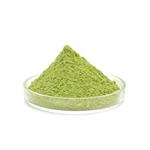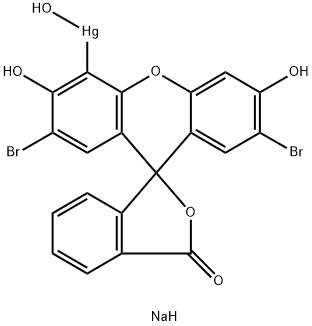- MERBROMIN
-

- $50.00 / 1kg
-
2025-03-07
- CAS:129-16-8
- Min. Order: 1kg
- Purity: 0.99
- Supply Ability: 10000
- Merbromin
-

- $40.00 / 500mg
-
2024-11-19
- CAS:129-16-8
- Min. Order:
- Purity: 98%
- Supply Ability: 10g
- Merbromin
-

- $40.00 / 500mg
-
2024-11-19
- CAS:129-16-8
- Min. Order:
- Purity: 98%
- Supply Ability: 10g
|
| | MERBROMIN Basic information |
| Product Name: | MERBROMIN | | Synonyms: | 2’,7’-dibromo-4’-(hydroxymercurio)-fluoresceidisodiumsalt;asceptichrome;aseptichrome;chromargyre;disodium2,7-dibrom-4-hydroxy-mercuri-fluorescein;disodium2’,7’-dibromo-4’-(hydroxymercury)fluorescein;domf;flavurol | | CAS: | 129-16-8 | | MF: | C20H11Br2HgNaO6 | | MW: | 730.69 | | EINECS: | 204-933-6 | | Product Categories: | FLUKIVER;Inhibitors;Organometallics | | Mol File: | 129-16-8.mol |  |
| | MERBROMIN Chemical Properties |
| | MERBROMIN Usage And Synthesis |
| Chemical Properties | dark green solid | | Originator | Mercurin,Monik | | Uses | Antiseptic and applied topically | | Uses | anthelmintic | | Definition | ChEBI: An organic sodium salt that is 2,7-dibromo-4-hydroxymercurifluorescein in which the carboxy group and the phenolic hydroxy group have been deprotonated and the resulting charge is neutralised by two sodium ions. | | Manufacturing Process | 49 g 2,7-dibromofluorescein are dissolved in a solution of 8 g of sodium hydroxide in 50 ml of water, and diluted to 200 ml 12.5 ml of glacial acetic acid are added to this solution with stirring. A homogeneous pasty precipitate results with vigorously stirring. A filtered solution of about 22.5 g of mercuric oxide in 25 ml of glacial acid and 50 ml water, diluted after solution to 100 ml, is then added to the suspended precipitate, and the whole diluted to about 500 ml. The mixture is boiled until a small portion of filtered solution gives no test for mercury when treated with ammonium sulfide, the approximate time required for this operation being about 4.5-6 hours. As the boiling continues the precipitate become darker in color and more granular. It is washed, preferably by centrifuging, to remove acetic acid and sodium acetate, and dried at about 110°C. By close adherence to above conditions an almost quantitative yield may be secured. The product may be regarded as consisting essentially of 2,7-dibromo-4-hydroxymercuryfluorescein, resulting from substantially complete hydrolysis of an acetoxy-mercury compound, which probably formed as an intermediate. It is red powder, which is insoluble in the usual solvents but dissolves in two equivalents of sodium hydroxide yielding a deep cherry-red solution. The solution has the tendency to decomposition on long standing. | | Therapeutic Function | Antiseptic | | Hazard | Toxic by ingestion. | | Flammability and Explosibility | Not classified | | Safety Profile | Poison by intravenous
and subcutaneous routes. Mutation data
reported. Relatively nonirritating and
nontoxic to damaged skin or tissue. A
topical antiseptic. An FDA over-the-counter
drug. When heated to decomposition it
emits very toxic fumes including fumes of
Na2O, Br-, and Hg. See also MERCURY
COMPOUNDS, ORGANIC. | | Purification Methods | The Na salt is dissolved in the minimum volume of H2O, or the free acid suspended in H2O and dilute NaOH is added to cause it to dissolve, filter and acidify it with dilute HCl. Collect the precipitate, wash it with H2O by centrifugation and dry it in a vacuum. The di Na salt can be purified by dissolving it in the minimum volume of H2O and is precipitated by adding EtOH, filter, wash it with EtOH or Me2CO and dry it in a vacuum. Its solubility in 95% EtOH is 2% and in MeOH it is 16%. [White J Am Chem Soc 42 2355 1920.] |
| | MERBROMIN Preparation Products And Raw materials |
|